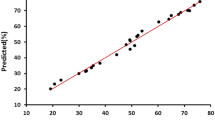Abstract
Two advance oxidation processes (AOPs), namely Fenton and photo-Fenton, was used to purify the Karun Petrochemical wastewater. In order to optimize the maximum chemical oxygen demand (COD) reduction, the effects of initial pH, H2O2, and FeSO4·7H2O doses and the exposure contact time of UV light were investigated during the purification process using response surface methodology (RSM) under the central composite design (CCD). The results revealed the fact that the optimum conditions for the photo-Fenton were obtained to be at initial pH of 4, H2O2 dose of 8 ml/l and FeSO4·7H2O dose of 2.33 g/l and time of 93.75 min. Under these circumstances, the highest COD removal of 83.51% was obtained. In the Fenton process, the optimum conditions at initial pH of 4, H2O2 dose of 8 ml/l, FeSO4·7H2O dose of 3.25 g/l, and UV exposure time of 92.39 min were achieved. Under these conditions, the COD removal was 73.09%.












Similar content being viewed by others
References
Abdelwahab O, Amin NK, El-Ashtoukhy EZ (2009) Electrochemical removal of phenol from oil refinery wastewater. J Hazard Mater 163(2):711–716
Ahmadi M, Vahabzadeh F, Bonakdarpour B, Mofarrah E, Mehranian M (2005) Application of the central composite design and response surface methodology to the advanced treatment of olive oil processing wastewater using Fenton's peroxidation. Journal of Hazardous Materials, 123(1):187–195
Ahmadi M, Vahabzade F, Moffarrah E, Aliabadi M (2004) Application of advanced oxidation of dephenolization of olive oil mill wastewater processing by fentons reagent. In Proc. 9th National Congress of Chem. Eng (pp. 23–25)
Akhbari A, Zinatizadeh AAL, Mohammadi P, Irandoust M, Mansouri Y (2011) Process modeling and analysis of biological nutrients removal in an integrated RBC-AS system using response surface methodology. Chem Eng J 168(1):269–279
Amini M, Younesi H (2009) Biosorption of Cd (II), Ni (II) and Pb (II) from aqueous solution by dried biomass of Aspergillus niger: application of response surface methodology to the optimization of process parameters. CLEAN–Soil, Air, Water 37(10):776–786
Amini M, Younesi H, Bahramifar N, Lorestani AAZ, Ghorbani F, Daneshi A, Sharifzadeh M (2008) Application of response surface methodology for optimization of lead biosorption in an aqueous solution by Aspergillus niger. J Hazard Mater 154(1):694–702
APHA (1999) Standard methods for the examination of water and wastewater. American Public Health Association, Washington, DC
Attiogbe FK, Glover-Amengor M, Nyadziehe KT (2007) Correlating biochemical and chemical oxygen demand of effluents–A case study of selected industries in Kumasi, Ghana. West African Journal of Applied Ecology 11(1):45722
Babuponnusami A, Muthukumar K (2014) A review on Fenton and improvements to the Fenton process for wastewater treatment. J Environ Chem Eng 2(1):557–572
Barbusiński K, Filipek K (2000) Aerobic sludge digestion in the presence of chemical oxidizing agents part II. Fenton’s reagent. Pol J Environ Stud 9(3):145–149
Da Costa PRF, Da Silva DR, Martínez-Huitle CA, Garcia-Segura S (2016) Fuel station effluent treatment by electrochemical technology. J Electroanal Chem 763:97–103
Diya’uddeen BH, Daud WMAW, Aziz AA (2011) Treatment technologies for petroleum refinery effluents: a review. Process Saf Environ Prot 89(2):95–105
Garcia-Segura S, Bellotindos LM, Huang YH, Brillas E, Lu MC (2016) Fluidized-bed Fenton process as alternative wastewater treatment technology—a review. J Taiwan Inst Chem Eng 67:211–225
Georgiou D, Melidis P, Aivasidis A, Gimouhopoulos K (2002) Degradation of azo-reactive dyes by ultraviolet radiation in the presence of hydrogen peroxide. Dyes Pigments 52(2):69–78
Ghaly MY, Härtel G, Mayer R, Haseneder R (2001) Photochemical oxidation of p-chlorophenol by UV/H 2 O 2 and photo-Fenton process. A comparative study. Waste Manag 21(1):41–47
Hird W (2006) Recycled water—case study: BlueScope steel, Port Kembla steelworks. Desalination 188(1–3):97–103
Ishak AR, Hamid FS, Mohamad S, Tay KS (2017). Removal of organic matter from stabilized landfill leachate using Coagulation-Flocculation-Fenton coupled with activated charcoal adsorption. Waste Management & Research, 35(7),739–746.
Kang YW, Hwang KY (2000) Effects of reaction conditions on the oxidation efficiency in the Fenton process. Water Res 34(10):2786–2790
Karimi B, Ehrampoush MH, Ebrahimi A, Mokhtari M (2013) The study of leachate treatment by using three advanced oxidation process based wet air oxidation. Iranian journal of environmental health science & engineering, 10(1):1
Kavitha V, Palanivelu K (2004) The role of ferrous ion in Fenton and photo-Fenton processes for the degradation of phenol. Chemosphere 55(9):1235–1243
Klamerth N, Malato S, Agüera A, Fernández-Alba A (2013) Photo-Fenton and modified photo-Fenton at neutral pH for the treatment of emerging contaminants in wastewater treatment plant effluents: a comparison. Water Res 47(2):833–840
Kušić H, Koprivanac N, Božić AL, Selanec I (2006) Photo-assisted Fenton type processes for the degradation of phenol: a kinetic study. J Hazard Mater 136(3):632–644
Lin M, Huang H, Liu Z, Liu Y, Ge J, Fang Y (2013). Growth–dissolution–regrowth transitions of Fe3O4 nanoparticles as building blocks for 3D magnetic nanoparticle clusters under hydrothermal conditions. Langmuir, 29(49), 15433-15441.
Lipczynska-Kochany E, Kochany J (2008) Effect of humic substances on the Fenton treatment of wastewater at acidic and neutral pH. Chemosphere 73(5):745–750
Ma F, Guo JB, Zhao LJ, Chang CC, Cui D (2009) Application of bioaugmentation to improve the activated sludge system into the contact oxidation system treating petrochemical wastewater. Bioresour Technol 100(2):597–602
Malato S, Blanco J, Vidal A, Richter C (2002) Photocatalysis with solar energy at a pilot-plant scale: an overview. Appl Catal B Environ 37(1):1–15
Malato S, Fernández-Ibáñez P, Maldonado MI, Blanco J, Gernjak W (2009) Decontamination and disinfection of water by solar photocatalysis: recent overview and trends. Catal Today 147(1):1–59
Mamane H, Shemer H, Linden KG (2007) Inactivation of E. coli, B. subtilis spores, and MS2, T4, and T7 phage using UV/H2O2 advanced oxidation. Journal of hazardous materials, 146(3):479–486
Meriç S, Selcuk H, Gallo M, Belgiorno V (2005) Decolourisation and detoxifying of Remazol red dye and its mixture using Fenton's reagent. Desalination 173(3):239–248
Montgomery DC (2001). Design and analysis of experiments Fifth Edition. By John Wiley & Sons. Inc. All rights reserved
Nousheen R, Batool A, Rehman MSU, Ghufran MA, Hayat MT, Mahmood T (2014) Fenton-biological coupled biochemical oxidation of mixed wastewater for color and COD reduction. J Taiwan Inst Chem Eng 45(4):1661–1665
Pardeshi SK, Patil AB (2008) A simple route for photocatalytic degradation of phenol in aqueous zinc oxide suspension using solar energy. Sol Energy 82(8):700–705
Pérez JF, Llanos J, Sáez C, López C, Cañizares P, Rodrigo MA (2017) Treatment of real effluents from the pharmaceutical industry: a comparison between Fenton oxidation and conductive-diamond electro-oxidation. Journal of environmental management, 195: 216-223.
Sponza DT, Gök O (2010). Effect of rhamnolipid on the aerobic removal of polyaromatic hydrocarbons (PAHs) and COD components from petrochemical wastewater. Bioresource technology, 101(3):914-924
Singh SK, Tang WZ (2013) Statistical analysis of optimum Fenton oxidation conditions for landfill leachate treatment. Waste Manag 33(1):81–88
Sponza D, Karaoǧlu N (2002) Environmental geochemistry and pollution studies of Aliaǧa metal industry district. Environ Int 27(7):541–553
Su CC, Chang AT, Bellotindos LM, Lu MC (2012) Degradation of acetaminophen by Fenton and electro-Fenton processes in aerator reactor. Sep Purif Technol 99:8–13
Verma M, Ghaly AE (2008) Treatment of Remazol Brilliant Blue dye effluent by advanced photo oxidation process in TiO2/UV and H2O2/UV reactors. Am. J. Engg. & Applied Sci, 1(3):230–240
Xu M, Wu C, Zhou Y (2017) Advanced treatment of petrochemical secondary effluent by Fenton: performance and organics removal characteristics. Water Sci Technol 75(6):1431–1439
Author information
Authors and Affiliations
Corresponding author
Additional information
Publisher’s Note
Springer Nature remains neutral with regard to jurisdictional claims in published maps and institutional affiliations.
Rights and permissions
About this article
Cite this article
Nazrifar, M., Bahramifar, N. & Younesi, H. Optimization of Fenton and Photo-Fenton-Based Advanced Oxidation Processes for COD Reduction of Petrochemical Wastewater: Application of Response Surface Methodology. Water Conserv Sci Eng 4, 89–112 (2019). https://doi.org/10.1007/s41101-019-00070-9
Received:
Revised:
Accepted:
Published:
Issue Date:
DOI: https://doi.org/10.1007/s41101-019-00070-9




